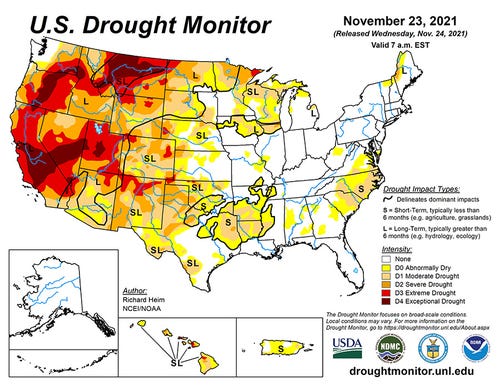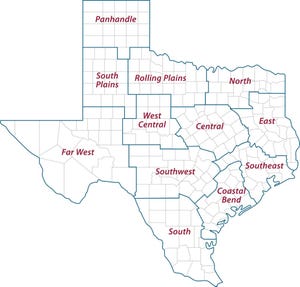
Conditions are drying around much of Texas, and forecasts are calling for winter weather to be warmer and drier than average.
Commodity producers in much of the state, including the High Plains, experienced a banner year in 2021 due to high commodity prices and above-average precipitation that started in May and delivered timely moisture throughout the growing season.
But soil moisture levels are declining in parts of the state, and the 2022 growing season could hinge on winter weather replenishing topsoil and subsoils or another round of timely summer rains to save the day.
 Planting wheat. A strong Niña weather pattern forecast for this winter may mean less rain and warmer temperatures.(Photo by Shelley E. Huguley)
Planting wheat. A strong Niña weather pattern forecast for this winter may mean less rain and warmer temperatures.(Photo by Shelley E. Huguley)
Jourdan Bell, Texas A&M AgriLife Extension Service agronomist, Amarillo, said drought conditions are expanding throughout the High Plains. The region has not received significant precipitation since September while above-average temperatures were exacerbating soil moisture level declines.
The U.S. Drought Monitor shows most of the High Plains, West Texas and East Texas are in extreme drought to abnormally dry. West Central, Central and Coastal parts of the state are not experiencing drought, according to the monitor.

A strong La Niña weather pattern is expected this winter, which often means less rainfall and warmer temperatures for the Southwest, including much of Texas.
“Soil moisture indexes are drying out and that is definitely a concern moving into winter and spring,” Bell said. “We are continuing to hear weather conditions are expected to be warmer and drier than average, and so moisture could be a challenge for producers looking to make 2022 cropping decisions.”
Winter weather typically dry for Texas Plains
Bell said producers in the High Plains are making serious evaluations of input costs due to high fertilizer prices and pesticide shortages despite strong commodity prices. But much of the planting decisions will be based on precipitation received between now and planting and how well soil moisture indexes might support crops through moderate drought conditions.
But winter is typically a dry period for the High Plains region, Bell said. Much of the restorative rainfall events historically occur during monsoon season in late summer through September.
The region does typically pick up some winter moisture from snowfall, Bell said. While snow represents important moisture and an insulator against extreme cold for soils and winter crops like wheat and oats, it only delivers a fraction of rainfall’s liquid equivalent.
“A few inches of moisture are important when you are in a 16-24-inch rain zone like the High Plains, but we need rainfall to help reduce the deficit and improve the overall topsoil and subsoil moisture index,” she said.
Plan for the worst, hope for the best
Bell said producers should expect to be increasingly dependent on timely rains if local and regional groundwater capacities continue to decline. The ability to meet crop moisture requirements directly impacts yield potential.
Timely in-season rains in the High Plains between May and September helped bridge the soil moisture deficit during the 2021 growing season, Bell said. The region received 10-12 inches of rainfall during the growing season, which effectively supplemented crop moisture requirements for producers with limited irrigation capacity.
The timely rains resulted in better-than-average yields for many regional corn, sorghum and cotton producers, she said. Better-than-expected yields amid higher prices at market made 2021 a good production year.
But Bell said producers should continue to plan for the worst and hope for the best when it comes to soil moisture availability. Competitive prices for more drought tolerant crops like cotton and sorghum will likely weigh into cropping decisions if moisture doesn’t improve soil moisture indexes.
“Generally, farmers have a positive, hopeful outlook when it comes to planting,” she said. “Last year many producers were reconsidering whether they would plant corn, but then rains came in May, so they planted hoping for more and they got it. Timely in-season rains and moderate temperatures led to very good corn yields. It worked out perfectly, but then there are years where it does not.”
AgriLife Extension district reporters compiled the following summaries:

CENTRAL
Weather remained dry. Winter wheat was slowly being planted under cooler conditions. Producers reported difficulty obtaining their choice wheat varieties. Ideally growers will plant by Dec 1. Soil moisture conditions were still very good and much better than last fall. Unplanted fields were being cultivated to destroy heavy volunteer grass and weed growth. Some planted fields with excessive volunteer weeds may be difficult to control in-season. The biggest producer concern was the high cost of fertilizers and whether investing in costly inputs with the strong La Niña conditions will pay off. There have been several announcements of industries buying and building on key Blackland farming areas. A new Samsung facility alone will claim 1,250 acres of historically prime soil, and land values are exploding, which is triggering industrial, commercial and residential land sales.
ROLLING PLAINS
Conditions were very dry with trace amounts of rainfall reported in a few areas and one county reporting up to 1 inch of rainfall. Wheat fields were planted, and some were replanted, but emergence has been poor so far. Very few stockers were on wheat pasture or native rangelands. There was some standing forage in areas. Supplemental hay was being fed to livestock. Cotton harvest was mostly completed.
COASTAL BEND
A cold front brought some welcome rain, which helped increase soil moisture. Fall fieldwork was on hold until conditions dry out a little. Winter pastures of oats, wheat and ryegrass were planted and progressing well. Livestock were doing well. Some cattle producers started feeding hay and protein. Pecan harvest continued as weather allowed.
EAST
Drought conditions persisted across the district. Sporadic rainfall slightly improved soil moisture. Winter pasture growth remained slow. Pasture and rangeland conditions were poor to fair. Subsoil and topsoil conditions were short to adequate. Producers in many counties began feeding hay and protein, and livestock were doing fair to good. Cattle markets were strong with prices ending firm to high. Wild pig activity continued to be a problem for landowners.
SOUTH PLAINS
Most cotton was harvested. A cold front delivered some rain but not enough moisture to make a difference. Winter wheat planting continued across the district. Most producers finished up peanut harvest and were working on sorghum, corn, sunflowers and cotton. Cattle were in good condition.
PANHANDLE
With a few exceptions, cotton harvest was complete. Extreme dry conditions were not helping winter wheat conditions. Rangeland and pastures were dormant, and supplemental feeding was occurring.
NORTH
Soil moisture ranged from very short to adequate with sporadic and drizzling rain reported. Temperatures dropped to the mid-40s. Oat conditions were very poor to excellent while winter wheat conditions ranged from fair to excellent. Pasture and rangeland conditions were mostly fair to good, but some counties reported very poor conditions. Livestock were in good condition. Some producers were utilizing stockpiled forage while others started feeding hay.
FAR WEST
Conditions were cooler with daytime highs around 60 degrees and lows in the high 30s. Areas received almost 0.25 of an inch of rainfall. Grasses were dormant and there was surplus fuel for fire season. Conditions were getting very dry. Wheat fields, rangelands and pastures needed some moisture. Producers continued to harvest cotton. Deer and quail hunters were around. Producers continued to feed wildlife and livestock.
WEST CENTRAL
Some areas received scattered showers last week, but more rain was needed to help wheat and pastures going into the winter months. Most warm-season forages stopped growth due to frost and supplemental feeding of livestock increased due to frost. Pecan harvest continued, but many producers did not report much of a crop. Cotton harvest continued to progress.
SOUTHEAST
Some areas received their first official frost. Livestock were healthy going into late fall and early winter months. Very little rainfall was reported, winter forages were up and growing with rainfall in the forecast. Winter rye, wheat and oats emerged and should continue to grow with rainfall. Warm season grass growth stalled as plants were entering dormancy. The second cutting of rice finished, and some producers were beginning to work the ground for next year’s rice crop.
SOUTHWEST
Light rains and cool temperatures were reported. Rangeland and pastures were improving where rainfall was received. Winter oat and wheat conditions were good. Some areas were reporting fewer planted wheat acres this year. Livestock were in fair to good condition, and producers were providing supplemental feed. Cattle, sheep and goat markets were good. Wildlife were in good condition.
SOUTH
Northern and western areas reported very short to short soil conditions while eastern areas reported short to adequate soil moisture. Southern areas reported adequate soil moisture levels. A cold front brought cooler temperatures and scattered rainfall with totals ranging up to almost 2 inches. Irrigated wheat and oat fields continued to develop. Farmers continued to prepare fields for next season. Rainfall halted some fieldwork due to wet conditions, and soil moisture conditions should be good for 2022 plantings. Some winter planting was delayed by rain as well. Pasture and rangeland conditions were declining in drier areas and improving in areas that received rainfall. Livestock supplemental feeding was increasing. Plenty of hay was available, but cattle feed prices continued to rise. Cows and calves looked good, and prices remained steady, but producers in drier areas were likely to thin herds. Fall crops and vegetables were emerging and progressing well, but some were suffering in drier areas. Cabbage was doing well, and many fields had been harvested once already. Food plots planted for wildlife were doing well. Corn and protein for deer were selling out at local stores. Stock tanks were full in some areas and beginning to dry in others.
About the Author(s)
You May Also Like




